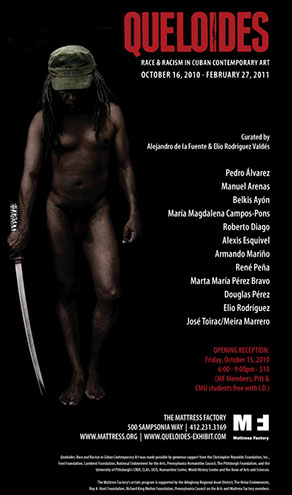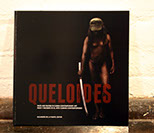PROYECTO
ANTECEDENTES
ARTISTAS
CONTACTO
LINKS
Wifredo Lam Center, Havana, Cuba
April 16th / May 30th 2010
Mattress Factory Art Museum, Pittsburgh, EUA
October 15th 2010/ February 27th 2011
8th Floor Gallery, NYC. EUA
April 12th, 2011
W.E.B. Du Bois for African American Research. Boston, EUA
January 25th/ May 30th, 2012
Queloides: Diez Años Después
Alejandro de la Fuente.
UCIS Profesor investigador de Historia y Estudios Latinoamericanos de la Universidad de Pittsburgh

“I don’t think you should talk about this topic,” an Afro-Cuban woman replied to a journalist from the popular weekly Bohemia in 1992 when asked about racial discrimination in the island. Roughly at the same time, a reader of the Miami Herald wrote in similar terms: “Please, do not speak about races, comments like these do us a lot of harm... what you are doing is dividing us.” This is perhaps one of the few areas in which most Cubans inside and outside the island agree: it is better not to discuss questions of race, which are frequently perceived as divisive and dangerous—a threat to Cuba’s racial harmony and national unity.
Students of race and racism in Latin America will not be surprised by this. In Cuba, as elsewhere in the region, most people are not only reluctant to discuss these questions in public, but quickly deny any charges of being personally prejudiced. The existence of racism may be acknowledged, but only as a social ill inherited from a past of colonialism and slavery which has not totally faded away yet. The great Brazilian sociologist Florestan Fernandes described this denial as “prejudice of having no prejudice.”
In the specific case of Cuba, this public silence on race is rooted in at least two important factors. First, since the late 19th century dominant interpretations of Cubanidad have consistently minimized racial differences, on the grounds that they endanger national unity. Based on a particular understanding of Jose Marti’s creed and his foundational myth of a republic “with all and for all,” these interpretations have opposed public debates about racism in Cuban society as a betrayal of Marti’s legacy and as attempts to divide an allegedly integrated, racially-harmonious nation. Second, although the revolutionary government called initially (in 1959) for a national public debate on race and discrimination, it quickly declared the problem solved, effectively shutting down discussions about this topic. As early as 1962 the authorities talked about racism and discrimination in past tense and formally proclaimed Cuba to be a discrimination-free society. As a government official put it, the revolution had “eliminated from Cuban life the odious and humiliating spectacle of discrimination because of skin color.” Race became a taboo in the Cuban public sphere; attempts to raise the issue were equated with efforts to create division in the revolutionary family. Given the government’s strict control over the media, this silence was in fact quite effective.
This silence, however, began to break in the 1990s, as the socialist welfare state, which was generously funded by Soviet subsidies, collapsed. The structural crisis of the 1990s, officially known as “The Special Period,” not only eroded some of the revolution’s most successful social programs (health, education, nutrition), but also resulted in growing social polarization, a widening income gap, and increased competition for employment and scarce resources. Social problems which the authorities had deemed solved reappeared, including prostitution and new forms of criminal activities.
Prominent among these unsolved problems was race, which in the 1990s reclaimed a central place in social relations. As Cubans of all colors and social classes were forced to compete for dwindling resources and for access to scarce American dollars, racial differences in income rapidly grew. Dollars could be obtained through a job in the growing tourist industry or from relatives in the United States. Most blacks did not have relatives in the Cuban-American community, which is over 90 percent white. They were also systematically barred by white managers from attractive jobs in the emerging tourist sector, on the grounds that blacks lacked the required cultural and aesthetic attributes such as “pleasant appearance.” Blackness continues to be equated with the most degrading physical and ethical attributes--ugliness, laziness, incompetence, vanity, and ignorance—and is also identified with the most despicable behaviors, from robbery and peddling, to prostitution and rape.
In these conditions the decades-old, official silence on race began to crumble. Since the early 1990s, a growing group of young Afro-Cuban intellectuals and artists—musicians, writers, painters, performers, academics, and activists—began to do something that was previously unthinkable in Cuban socialist society: they began to denounce the persistence of racially-discriminatory ideas and practices in the island. These intellectuals and activists have articulated the frustrations, concerns, and aspirations of the black youth, a sector of the population that came to age in the late 1980s and early 1990s. Unlike their elders, who were protagonists and first-hand witnesses of the profound social transformations that Cuban society experienced during the 1960s and 1970s, these black youths grew up in a relatively egalitarian society, only to see that equality erode in front of their own eyes.
Among those denouncing the resurgence of racism in Cuban society is a group of visual artists who organized three now largely forgotten, but very important exhibits between 1997 and 1999. Titled Queloides Primera Parte (1997) and Queloides (1999), and Neither Musicians nor Athletes (1997), these exhibits sought to offer what artist Alexis Esquivel described as “a non-romanticized vision of the daily experience of Cuban blacks” and a forum to raise “questions and concerns about racial prejudice in Cuba.” Some of the artists participating in the exhibits, such as Esquivel, Elio Rodríguez (El Macho), and Roberto Diago, denounced the creation of visual and sexual stereotypes of Afro-Cubans for tourist consumption. Others, such as photographer René Peña or painters Esquivel, Manuel Arenas and Douglas Perez, used their work to expose and ridicule racist fears. Those exhibits are now almost completely forgotten. They never resulted in a catalog and were barely noticed in the national press, even though it was the first time that a group of visual artists came together to discuss questions of race and racism in post-revolutionary Cuba.
The current exhibit, which would be the third edition of Queloides, seeks to continue the conversations initiated by these artists over ten years ago and to recover the memory of those efforts as well. Besides, racism has certainly not disappeared from Cuban society during the last ten years. As the musicians of the rap group Hermanos de Causa state in one of their poetic lyrics, “Don’t you tell me that there isn’t any, because I have seen it; don’t tell me that it doesn’t exist, because I have lived it… Don’t say there is no racism… prejudice is always there.” It is to fight against prejudice, it is to dismantle racism, in Cuba or anywhere else in the world, that Queloides was conceived.
curatorial project by: Alejandro de la Fuente and Elio Rodriguez

